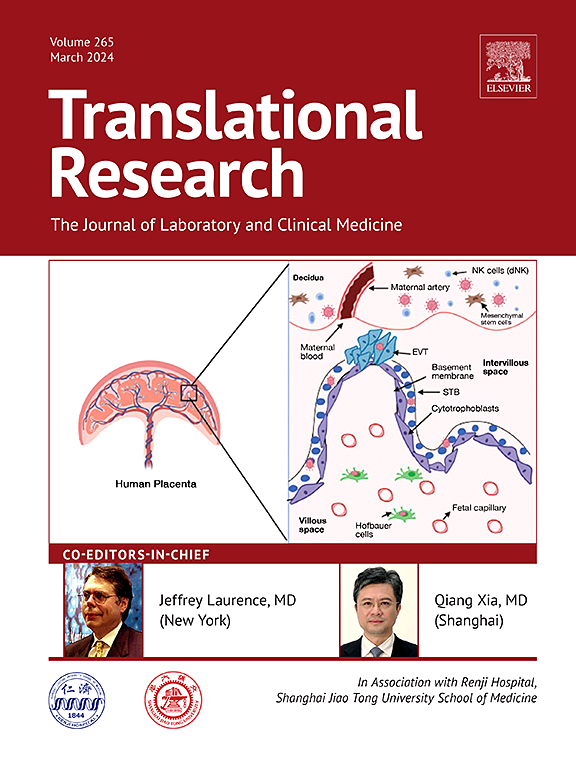一种新的严重急性呼吸窘迫综合征兔模型:吸酸和有害机械通气的协同作用。
IF 5.9
2区 医学
Q1 MEDICAL LABORATORY TECHNOLOGY
引用次数: 0
摘要
背景:急性呼吸窘迫综合征(ARDS)以严重炎症和肺水肿为特征,常导致呼吸衰竭。本研究旨在建立稳定、相关的急性呼吸窘迫综合征(ARDS)兔吸入盐酸(HCl)和呼吸机致肺损伤(VILI)模型。方法:将成年新西兰兔分为生理盐水组(n=9)、1击3.0组(HCl 3 ml/kg, n=7)、1击6.0组(HCl 6 ml/kg, n=7)、2击3 ml/kg组(HCl 3 ml/kg,通气VT 20 ml/kg, 0 PEEP, RR 20 ~ 30 bpm, FiO2 1.0模拟VILI, n=14)。肺损伤诱导后4 h,每h测定PaO2/FiO2比值、氧合指数、氧饱和度、PaCO2、通气效率指数、肺泡-动脉梯度。死后分析包括支气管肺泡灌洗液(BALF)总细胞计数和分化细胞计数,肺水肿形成评估,肺组织生化和组织学检查。结果:与生理盐水组相比,2击组肺功能参数(P/F比、氧合指数、通气效率指数、肺泡-动脉梯度)均明显恶化。同样,在1击6.0的组中观察到恶化。在分析炎症谱时,我们观察到与生理盐水组相比,2 hit组BALF中的趋化因子和细胞因子(TNFα、IL-1β、IL-6、IL-8、ET-1、MCP、H1F、MIP)水平和氧化应激参数(3NT、MDA、AOPP、过氧化氢酶和GSH/GSSG)水平显著升高。单独气管内给药HCl作为两种损伤的组合对炎症没有显著影响。与生理盐水组相比,2击组和1击6.0组均观察到肺干湿重比(W/D)增加,表明肺水肿。与生理盐水组、1击3.0和1击6.0相比,2击组BALF蛋白含量和肺损伤总评分均升高。结论:盐酸吸入联合呼吸机诱导的肺损伤可靠地再现了严重ARDS的关键特征,为研究其复杂的病理生理和评估新的治疗干预措施提供了一个可靠的临床相关模型。本文章由计算机程序翻译,如有差异,请以英文原文为准。
A novel rabbit model of severe ARDS: Synergistic effects of acid aspiration and harmful mechanical ventilation
Background
Acute respiratory distress syndrome (ARDS) is characterised by severe inflammation and pulmonary edema, often leading to respiratory failure. This study aims to develop a stable and relevant rabbit model of severe ARDS using hydrochloric acid (HCl) aspiration and ventilator-induced lung injury (VILI).
Methods
Adult New Zealand rabbits were divided into four groups: Saline (n = 9), 1-hit 3.0 (HCl 3 ml/kg, n = 7), 1-hit 6.0 (HCl 6 ml/kg, n = 7), and 2-hit (HCl 3 ml/kg and ventilation with VT 20 ml/kg, zero PEEP, RR 20-30 bpm, and FiO2 1.0 to mimic VILI, n = 14). PaO2/FiO2 ratio, oxygenation index, oxygen saturation, PaCO2, ventilation efficiency index and alveolar-arterial gradient were evaluated every hour for 4 h after induction of lung injury. The post-mortem analysis included total and differential cell counts in bronchoalveolar lavage fluid (BALF), evaluation of lung edema formation, biochemical and histological examination of lung tissue.
Results
In the 2-hit group, we observed a significant deterioration of all lung function parameters (P/F ratio, oxygenation index, ventilation efficiency index, and alveolar-arterial gradient) compared to the saline group. Similarly, a deterioration was observed in the 1-hit 6.0 group. When analysing the inflammatory profile, we observed significantly increased levels of chemokines and cytokines (TNFα, IL-1β, IL-6, IL-8, ET-1, MCP, H1F, MIP) and oxidative stress parameters (3NT, MDA, AOPP, catalase and GSH/GSSG) in BALF in the 2-hit group compared to the saline group. Intratracheal administration of HCl alone did not have a significant impact on inflammation as the combination of two insults. An increased wet-to-dry lung weight ratio (W/D), indicative of pulmonary edema, was observed in both the 2-hit and 1-hit 6.0 groups compared to the saline group. An increased level of protein content in BALF and total lung injury score were observed in the 2-hit group compared to the saline group, 1-hit 3.0 and 1-hit 6.0.
Conclusion
The combination of hydrochloric acid aspiration and ventilator-induced lung injury reliably reproduces key features of severe ARDS, offering a robust and clinically relevant model for investigating its complex pathophysiology and evaluating novel therapeutic interventions.
求助全文
通过发布文献求助,成功后即可免费获取论文全文。
去求助
来源期刊

Translational Research
医学-医学:内科
CiteScore
15.70
自引率
0.00%
发文量
195
审稿时长
14 days
期刊介绍:
Translational Research (formerly The Journal of Laboratory and Clinical Medicine) delivers original investigations in the broad fields of laboratory, clinical, and public health research. Published monthly since 1915, it keeps readers up-to-date on significant biomedical research from all subspecialties of medicine.
 求助内容:
求助内容: 应助结果提醒方式:
应助结果提醒方式:


